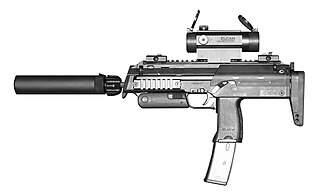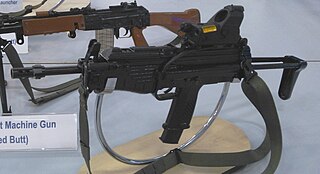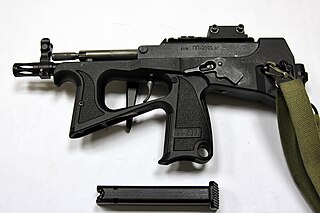 W
WPersonal defense weapons (PDWs) are a class of compact, selective fire, magazine-fed, submachine gun-like firearms. Most PDWs fire a small-caliber, high-velocity centerfire bottleneck cartridge resembling a scaled-down intermediate rifle cartridge, essentially making them an "in-between" hybrid between a submachine gun and a carbine. The use of these rifle-like cartridges gives the PDWs much better ballistic performance than conventional submachine guns, which fire larger-caliber but slower and less aerodynamic handgun cartridges. The low recoil of these "sub-intermediate" cartridges also makes muzzle rise on PDWs much easier to handle than short-barreled rifles, especially when shooting full-auto or in burst fires.
 W
WThe AAC Honey Badger PDW is an integrally suppressed personal defense weapon based on the AR-15. It is chambered in .300 AAC Blackout and was produced by Advanced Armament Corporation (AAC). The weapon is named after the honey badger.
 W
WThe Amogh Carbine is a select-fire personal defense weapon designed & manufactured by Ordnance Factories Board. It is a derivative of the Excalibur rifle, which in turn is a development of the INSAS rifle.
 W
WThe Bushmaster Arm Pistol was a 5.56×45mm NATO firearm, categorizeable as either a long pistol or compact carbine rifle, produced by the Gwinn Firearms Company, and later Bushmaster Firearms Inc. The firearm was a new design, having a tipping-block bolt system combined with a long stroke piston system similar to the AK-47 rifle.
 W
WThe Chauchat-Ribeyrolles 1918 submachine gun is a French prototype automatic weapon.
 W
WThe FN P90, also known as the FN Project 1990 PDWS, is a compact 5.7×28mm personal defense weapon designed and manufactured by FN Herstal in Belgium. Created in response to NATO requests for a replacement for 9×19mm Parabellum firearms, the P90 was designed as a compact but powerful firearm for vehicle crews, operators of crew-served weapons, support personnel, special forces, and counter-terrorist groups.
 W
WThe SCAR is a family of gas-operated automatic rifles developed by Belgian manufacturer FN Herstal (FN) in 2004. It is constructed with modularity for the United States Special Operations Command (SOCOM) to satisfy the requirements of the SCAR competition. This family of rifles consist of two main types. The SCAR-L, for "light", is chambered in 5.56×45mm NATO cartridge and the SCAR-H, for "heavy", is chambered in 7.62×51mm NATO. Both are available in Close Quarters Combat (CQC), Standard (STD), and Long Barrel (LB) variants.
 W
WThe Heckler & Koch G11 is a non-production prototype assault rifle developed from the late 1960s–1980s by Gesellschaft für Hülsenlose Gewehrsysteme (GSHG), a conglomeration of companies headed by firearm manufacturer Heckler & Koch, Dynamit Nobel, and Hensoldt Wetzlar. The rifle is noted for its use of caseless ammunition.
 W
WThe MP5 is a 9x19mm Parabellum submachine gun, developed in the 1960s by a team of engineers from the German small arms manufacturer Heckler & Koch GmbH (H&K) of Oberndorf am Neckar. There are over 100 variants and clones of the MP5, including some semi-automatic versions.
 W
WThe Heckler & Koch MP7 is a personal defense weapon chambered for the HK 4.6×30mm armor-piercing cartridge designed by German defence manufacturer Heckler & Koch.
 W
WThe Knight's Armament Company 6×35mm PDW is an experimental personal defense weapon designed by Knight's Armament Company (KAC), firing a 6mm cartridge optimized for short barrel weapons. A variant chambered in .300 AAC Blackout is also available.
 W
WThe Joint Venture Protective Carbine (JVPC), also known as Modern Sub Machine Carbine (MSMC) until 2014, is an Indian submachine gun designed by the Armament Research and Development Establishment of the Defence Research and Development Organisation, manufactured by the Ordnance Factory Board at Small Arms Factory, Kanpur and Ordnance Factory Tiruchirappalli. It was developed for the Indian Army, based on previous experience from the INSAS family of firearms.
 W
WThe PP-2000 is a submachine gun/machine pistol made by the KBP Instrument Design Bureau. It was first publicly displayed at the Interpolytech-2004 exhibition in Moscow even though its patent was filed in 2001 and issued in 2003.
 W
WThe QCW-05 is a suppressed bullpup submachine gun, manufactured and developed by the People's Liberation Army (PLA) 208 Research Institute and Jianshe Industries (Group) Corporation of Chongqing under the China South Industries Group for the People's Liberation Army Ground Force, the People's Liberation Army Special Operations Forces and the People's Armed Police. This weapon is designed for the 5.8×21mm DCV05 sub-sonic round that is also used by the QSW-06 Silenced Pistol.
 W
WThe Saab Bofors Dynamics CBJ-MS is a personal defense weapon/submachine gun designed and manufactured by Swedish weapon developer CBJ Tech AB, and was also manufactured by Saab Bofors Dynamics. It can be chambered for both 6.5×25mm CBJ and 9×19mm Parabellum cartridges via simple barrel changes.
 W
WThe SIG MCX is a family of firearms designed and manufactured by SIG Sauer, produced in both selective fire and semi-automatic only models, and features a short-stroke gas piston system, which is inherited from the earlier SIG MPX submachine gun. The MCX is available in rifle, carbine, short-barreled rifle, and pistol configurations.
 W
WThe SR-2 "Veresk" is a Russian submachine gun designed to fire the 9×21mm Gyurza pistol cartridge.
 W
WThe CPW is a multi-caliber submachine gun developed by ST Kinetics of Singapore as a PDW-class firearm. The prototype is chambered in 9×19mm Parabellum but the manufacturer assures that the weapon's modular design allows for a simple caliber conversion to either 5.7×28mm or 4.6×30mm.
 W
WThe Uzi is a family of Israeli open-bolt, blowback-operated submachine guns first designed by Major Uziel "Uzi" Gal in the late 1940s, shortly after the establishment of the State of Israel. It is one of the first weapons to incorporate a telescoping bolt design, which allows the magazine to be housed in the pistol grip for a shorter weapon.